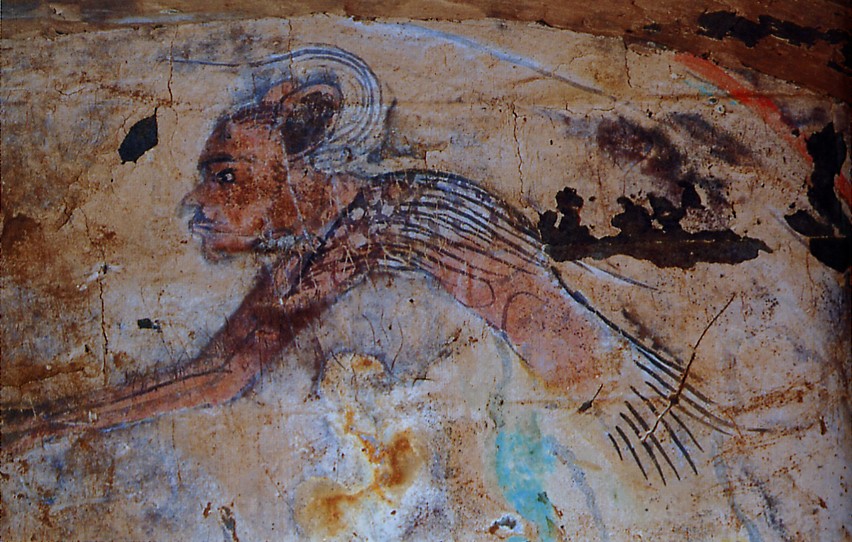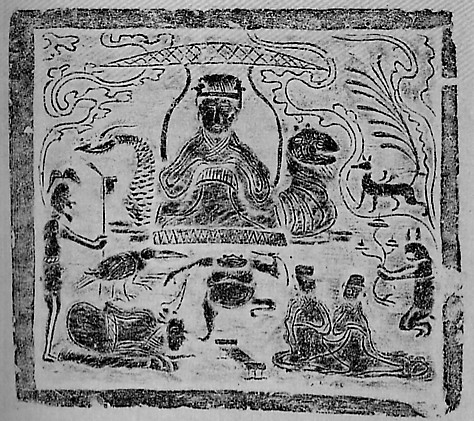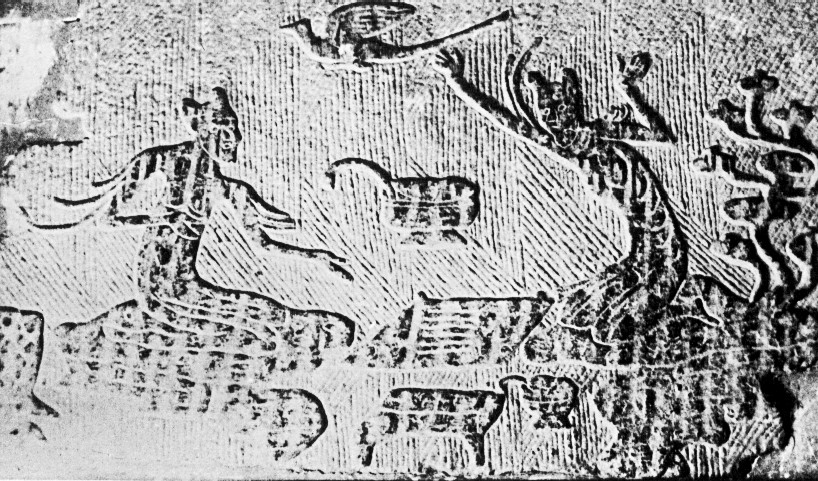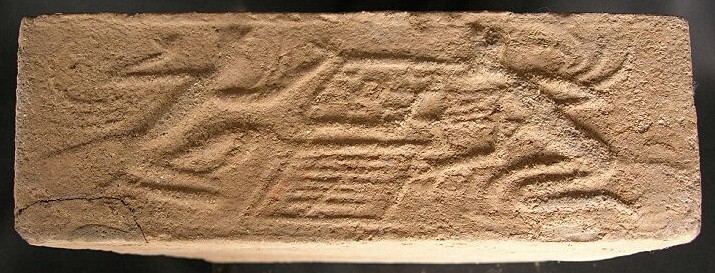BabelStone Blog
Saturday, 8 August 2009
The Lost Game of Liubo Part 3 : Pictures of Immortals playing Liubo
- Part 1 : Funerary Statuettes of Liubo Players
- Part 2 : Pictures of People playing Liubo
- Part 3 : Pictures of Immortals playing Liubo
- Part 4 : Liubo Boards and Game Equipment
- Part 5 : Liubo Divination
- Part 6 : Liubo Patterns on Mirrors and Coins
- Appendix : Eighteen-Sided Dice
One intriguing motif that is found mainly on engraved stone coffins from the area of modern Sichuan province is that of two elven "immortals" (仙人) or "feathered men" (羽人) engaged in a game of Liubo.

Source : Sichuan Handai Huaxiang Xuanji 四川漢代畫象選集 (Shanghai, 1955) fig.35
These immortals are very different to later depictions of Daoist immortals : both figures appear to be naked, with thin, sinuous bodies, wispy wings sprouting from their shoulders, and two distinctive protrusions on their heads. These protrusions have been variously described as horns or topknots, but I believe that they are in fact enormous ears, as can be seen from this painting of a winged immortal riding a dragon from a late Western Han tomb mural that was discovered in the ancient capital city of Chang'an in 2004 :
Source : Wen Wu 文物 2006.5 page 26
Is this evidence of alien visitation to ancient China ?
Or do the long nose, moustache and generally non-Chinese features indicate that the Chinese believed that the Indo-European peoples to the west of China were a race of supernatural beings ?
In many cases the two immortals playing Liubo are on the edge of a larger scene centred on the Queen Mother of the West (Xiwangmu 西王母) and her retinue, including the three-legged sun crow (三足烏), the moon toad (蟾蜍), the hare who pounds the elixir of immortality (and who in later mythology displaces the toad as the main denizen of the moon), and the nine-tailed fox (九尾狐狸).
Source : Mysteries of Ancient China (London, 1996) figure 101.1
[Queen Mother of the West on her Dragon and Tiger throne, together with a three-legged crow, a dancing toad, a hare holding sacred fungus, and a winged nine-tailed fox]
Jessica Rawson notes that the long low table at the bottom of the image "was perhaps used for the game of liubo" (Mysteries of Ancient China p. 197), but I think this was not the case as Liubo players are inevitably shown with the distinctive Liubo board and/or a square throwing mat, and this long thin table fulfills neither rôle.
The cult of the Queen Mother of the West was widespread during the Han dynasty, and she is the most commonly found divinity on Han picture stones, picture bricks and engraved stone coffins. I believe that the images of two immortals playing Liubo in scenes associated with the Queen Mother of the West are not just random pictures of any old immortals who happen to be playing a game of Liubo, but are two specific immortals, and the game of Liubo that they are playing reflects a specific story from the mythology surrounding the Queen Mother of the West. The images of these two fairy-like Liubo players are largely restricted to the region of modern Sichuan province, and so it is likely that they reflect the local mythology of the ancient Ba 巴 and Shu 蜀 cultures. Although the the story behind this game of Liubo is now lost, I think that we can at least identify who the two players are.
The key to unlocking the mystery of who these two Liubo players are is an unusual design of bronze pictorial mirror (畫像鏡) made exclusively by a certain Master Bo 柏師 of the Wu 吳 region of eastern China (see 5.1 and 5.2). This type of mirror depicts various mythological scenes and fabulous creatures, including two feathered immortals playing Liubo :

Source : 中秋到了,发一面;富贵寿宜神兽镜
The Liubo players are not identified directly, but on either side of the players stands a horse with its head in a trough facing the player. The horse next to one player is labelled 王喬馬 wáng qiáo mǎ "Wang Qiao's horse" and the horse next to the other player is labelled 赤誦馬 chì sòng mǎ "Chi Song's horse", which strongly suggests that the two players must be Wang Qiao and Chi Song, who were (or should I say "are") two famous immortals.
Wang Qiao 王喬 (also called Wang Ziqiao 王子喬) is variously recorded as originally being the son of King Ling of Zhou 周靈王 (reigned 571–545); the county magistrate of Ye County 葉縣 in Hedong 河東 (in modern Shanxi province) during the reign of Emperor Ming of Han (reigned 58–75); a man from the ancient State of Yue in the south of China; or a man from Wuyang 武陽 in the State of Shu 蜀 (modern Peng County 彭縣 in Sichuan). According to various sources each of these four attained immortality, and later became revered as a Daoist immortal. It is likely that in fact they all refer to the same immmortal, and are merely later attempts to provide a mortal history for an existing immortal.
Chi Song 赤誦 is an alternative form of the name of Chi Song 赤松 or Chisongzi 赤松子 meaning "Red Pine", who according to legend was the Master of Rain (雨師) during the reign of the legendary emperor Shennong 神農. He was able to set fire to himself without harm, and frequently visited the Queen Mother of the West in her stone dwelling on Mount Kunlun 崑崙山.
Wang Qiao and Chi Song are very often mentioned together, as in this quote from the 2nd century BCE Huainanzi, which is perhaps the earliest surviving account of either of these two immortals :
王喬、赤松,去塵埃之間,離群慝之紛,吸陰陽之和,食天地之精,呼而出故,吸而入新,虛輕舉,乘雲遊霧,可謂養性矣,而未可謂孝子也。《淮南子・泰族訓》
Wang Qiao and Chi Song turned their back on the dusty world and left behind the entanglements of multitudinous sins. They breathed in the harmony of the yin and the yang, and consumed the essence of heaven and earth. When they breathed out they expelled the old, and when they breathed in they absorbed the new. Empty and light they lift up, and ride on the clouds and travel with the mist. This could indeed be called nourishing one's nature, but it could hardly be called the acts of a filial son. Huainanzi chapter 20 (Grand Reunion)
Not only are these two immortals often paired together, but they are both mostly associated with southern China and Chu culture. The poem Yuǎnyóu 遠遊 "Far-off Journey" in the Chu Ci 楚辭 anthology features Wang Qiao and Chi Song prominently :
漠虛靜以恬愉兮,澹無為而自得。
聞赤松之清塵兮,願承風乎遺則。
...
春秋忽其不淹兮,奚久留此故居。
軒轅不可攀援兮,吾將從王喬而娛戲。
...
順凱風以從游兮,至南巢而一息。
見王子而宿之兮,審一氣之和德。
曰:「道可受兮,不可傳;
其小無內兮,其大夫垠;
毋滑而魂兮,彼將自然;
一氣孔神兮,於中夜存;
虛以待之存,無以為先;
庶類以成兮,此德之門。」
聞至貴而遂徂兮,忽乎吾將行。
仍羽人於丹丘,留不死之舊鄉。
In emptiness and silence I found serenity;
In tranquil inaction I gained true satisfaction.
I heard how once Red Pine had washed the world's dust off:
I would model myself on the pattern he had left me.
...
Spring and autumn hurried by, never delaying:
I could not go on staying in my old home for ever.
Xuan Yuan was too remote for me to aspire to;
But I could follow Wang Qiao for my delight.
...
Drifting in the wake of the gentle south wind,
I traveled to Nan-chao in a single journey.
There I saw Master Wang and made him salutation,
And asked about the balance made by unifying essence.
He said:
‘The Way can only be received, it cannot be given.
Small, it has no content; great, it has no bounds.
Keep you soul from confusion, and it will come naturally.
By unifying essence, strengthen the spirit; preserve it inside you in the midnight hour.
Await it in emptiness, before even Inaction.
All other things proceed from this: this is the Door of Power.’Having heard this precious teaching, I departed,
And swiftly prepared to start off on my journey.
I met the Feathered Men on the Hill of Cinnabar;
I tarried in the ancient land of Immortality.David Hawkes, The Songs of the South (Penguin Books, 1985) pages 194–196.
So it is my belief that Wang Qiao and Chi Song (Red Pine) are the two immortals shown playing Liubo on Master Bo's mirrors (but why the horses? I have found no source that refers to them as horse-riders, and indeed they are especially known as riders of clouds and mist); and that they are also the same two immortals depicted on all the Han dynasty stone coffins and picture bricks/stones from the Sichuan region. But why they are depicted playing Liubo, and why this depiction of immortals playing Liubo is only found in the Sichuan region, remains somewhat of a mystery. My suspicion is that the later motif of two immortals playing the game of Weiqi (Go) in the mountains was derived from some now lost story of Wang Qiao and Red Pine playing Liubo on Mount Kunlun : when Liubo lost its popularity after the end of the Han dynasty, the two immortals simply changed their game from Liubo to Weiqi.
4. Picture Stones and Picture Bricks
4B. Scenes showing Fairy Liubo Players
4B.1 Engraving on an Eastern Han stone coffin from Sichuan
四川郫縣新勝鄉出土東漢畫像石棺
Source : Zhongguo Meishu Quanji 中國美術全集・繪畫編 (Shanghai, 1988) vol.18 plate 91
Provenance : Xinsheng, Pi County, Sichuan. {30.895°N 103.765°E}
Current Location : Sichuan Provincial Museum (四川省博物館藏)
Date : Eastern Han (25 CE – 220 CE)
Size : 89.0 × 225.0 cm.
Notes : Engraving on the side of a stone coffin. The Queen Mother of the West, on her dragon and tiger throne, is in the centre of the picture, with the familiar toad, hare, nine-tailed fox and three-legged crow on her right side, and two fairy Liubo players on a mountain (presumably Kunlun mountain 崑崙山) to her left. The throwing mat is between them, and the liubo board closer to the foreground, but rather indistinct.
4B.2 Engraving on an Eastern Han stone coffin from Sichuan
四川新津宝子山崖墓出土東漢畫像石
Source : Sichuan Handai Diaosu Yishu 四川漢代彫塑藝術 (Beijing, 1959) fig.47
[also Sichuan Handai Huaxiang Xuanji 四川漢代畫象選集 (Shanghai, 1955) fig.35]
[also Zhongguo Gudaishi Cankao Tulu: Qian-Han Shiqi 中國古代史參考圖錄・秦漢時期 (Shanghai, 1990) page 233]
[also Zhongguo Diaosushi Tulu 中国雕塑史图录 (Shanghai, 1983) vol.1 page 273]
Provenance : Baozi Shan, Xinjin, Sichuan. {30.402°N 103.818°E}
Current Location : Unknown.
Date : Eastern Han (25 CE – 220 CE)
Size : 57.0 × 99.0 cm.
Notes : End of a stone coffin. The two fairy players appear to be naked, and have wispy wings and enormous ears. The throwing mat is placed between them, with a low Liubo table closer to the foreground, and a large wine bowl with a ladle on the other side of the throwing mat. Behind one of the fairy players grows the sacred Lingzhi fungus, and a bird flies overhead. The player on the right seems to have just thrown the six throwing sticks, which lie in a row on the mat, whilst the player on the left is raising up his hands as if questioning the result of the throw.
4B.3 Engraving on an Eastern Han stone coffin from Sichuan
四川簡陽縣深洞村鬼頭山東漢崖墓3號石棺左壁畫像
Source : Wen Wu 文物 1991.3
Provenance : Guitou Mountain, Shendong Village, Jianyang, Sichuan. {30.232°N 104.310°E}
Current Location : Unknown.
Date : Eastern Han (25 CE – 220 CE)
Size : Unknown.
Notes : Left side of an engraved stone coffin. The two figures on the right appear to be playing Liubo, although it is not very clear. Unlike the fairy players seen on other coffins, these two figures are wearing long feather head-dresses, and the one on the left appears to have fur or spines down his back.
4B.4 Engraving on an Eastern Han stone coffin from Sichuan
四川新津縣堡字山出土畫像石棺
Source : Sichuan Handai Huaxiang Xuanji 四川漢代畫象選集 (Shanghai, 1955) fig.26
[also Zhongguo Gudaishi Cankao Tulu: Qian-Han Shiqi 中國古代史參考圖錄・秦漢時期 (Shanghai, 1990) page 233]
Provenance : Baozi Shan, Xinjin, Sichuan. {30.402°N 103.818°E}
Current Location : Unknown.
Date : Eastern Han (25 CE – 220 CE)
Size : Unknown.
Notes : A large bird on the left side of the players recollects the bird flying over the players in Picture 4B.2. The players are shaded by what appears to be peacock (or phoenix) feathers, but maybe it is meant to be sacred fungus.
4B.5 Engraving on an Eastern Han stone coffin from Sichuan
四川宜賓縣公子山東漢崖墓出土畫像石棺
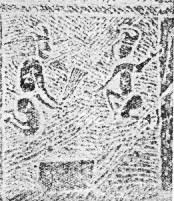
Source : Wen Wu 文物 1982.7
Provenance : Gongzishan, Yibin, Sichuan. {28.698°N 104.527°E}
Current Location : Unknown.
Date : Eastern Han (25 CE – 220 CE)
Size : Unknown.
4B.6 Eastern Han picture brick from Sichuan
四川新都縣出土漢代畫像磚
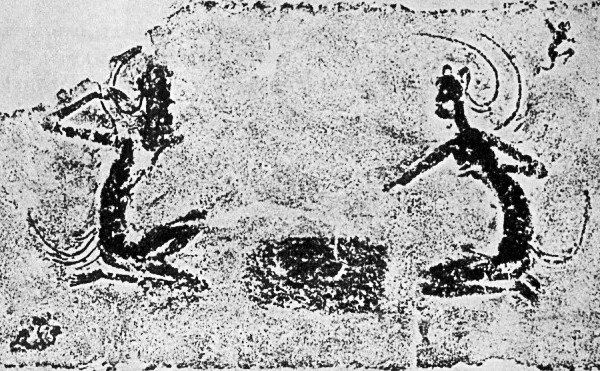
Source : Sichuan Handai Huaxiangzhuan 四川漢代畫像磚 (Shanghai, 1987) fig.35
Provenance : Xindu, Sichuan. {30.825°N 104.155°E}
Current Location : Unknown.
Date : Eastern Han (25 CE – 220 CE)
Size : Unknown.
Notes : Are those tails? And what is the tiny figure above the player on the right?
4B.7 Eastern Han picture brick from Sichuan
四川廣漢縣出土漢代畫像磚

Source : Sichuan Handai Huaxiangzhuan 四川漢代畫像磚 (Shanghai, 1987) fig.115
Provenance : Guanghan, Sichuan. {31.00°N 104.30°E}
Current Location : Unknown.
Date : Eastern Han (25 CE – 220 CE)
Size : Unknown.
Notes : One of very few pictures of immortals playing Liubo that show an observer, in this case with an outstretched arm as if he is joining in the game.
4B.8 Eastern Han picture brick from Sichuan
四川德陽縣出土漢代畫像磚
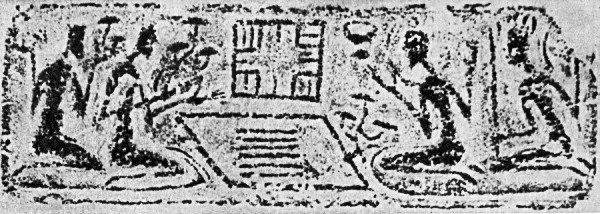
Source : Sichuan Handai Huaxiangzhuan 四川漢代畫像磚 (Shanghai, 1987) fig.116
Provenance : Deyang, Sichuan. {31.13°N 104.40°E}
Current Location : Unknown.
Date : Eastern Han (25 CE – 220 CE)
Size : Unknown.
Notes : Sacred fungus in front of the player on the right, and above the player on the left.
4B.9 Eastern Han picture brick from Sichuan
四川出土漢代畫像磚
Source : 中国画像石网
Provenance : Unknown.
Current Location : Unknown.
Date : Eastern Han (25 CE – 220 CE)
Size : Unknown.
4B.10 Engraving on an Eastern Han stone watch tower from Sichuan
四川渠縣土溪鄉趙家村貳無銘東漢闕
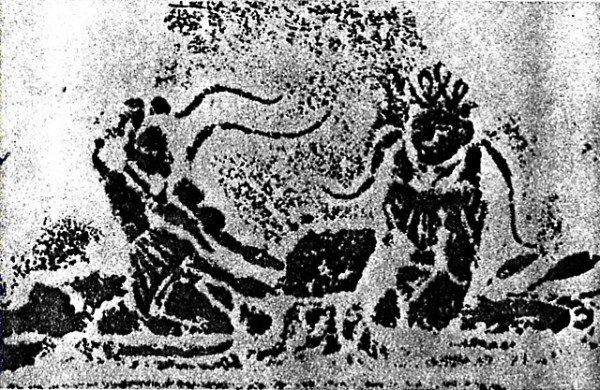
Source : Sichuan Handai Shique 四川漢代石闕 (Beijing, 1992) fig.219
Provenance : Zhaojia Village, Tuxi, Qu County, Sichuan. {31.023°N 107.040°E}
Current Location : Unknown.
Date : Eastern Han (25 CE – 220 CE)
Size : Unknown.
Notes : Detail from the back of the main building showing two figures playing Liubo. It is not clear whether they are mortal or immortal players, but if they are immortals their clothing and head-dresses are unusual.
4B.11 Engraving on an Eastern Han stone coffin from Yunnan
雲南昭通省耕塘西面梁子墓出土東漢畫像石
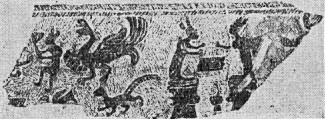
Source : Wen Wu 文物 1960.6 page 49
Provenance : Shenggengtang, Zhaotong, Yunnan. {27.355°N 103.725°E}
Current Location : Zhaotong County Hall of Cultural Relics (昭通縣文物館)
Date : Eastern Han (25 CE – 220 CE)
Size : Unknown.
Notes : Decoration on a stone coffin, also depicting the Queen Mother of the West, a nine-tailed fox and the three-legged sun crow.
4B.12 Eastern Han picture brick from Henan
河南漢代畫像磚
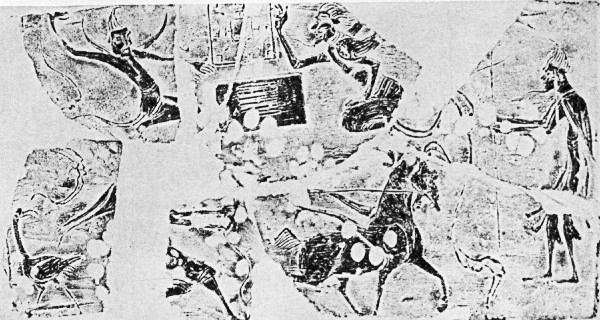
Source : Henan Handai Huaxiangzhuan 河南漢代畫像磚 (Shanghai, 1985) fig.240
Provenance : Henan.
Current Location : Unknown.
Date : Eastern Han (25 CE – 220 CE)
Size : Unknown.
Notes : This is one of only a very few examples of a depiction of fairy Liubo players from outside of Sichuan.
5. Pictorial Mirrors
5.1 Bronze picture mirror from Zhejiang
浙江紹興灕渚出土東漢神獸帶鏡
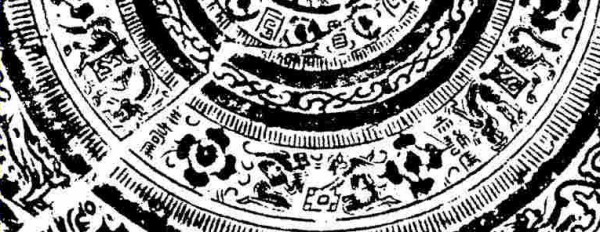
Source : Zhejiang Chutu Tongjing 浙江出土銅鏡 (Beijing, 1987) plate 24
Provenance : Lizhu, Shaoxing, Zhejiang. {29.955°N 120.475°E}
Current Location : Unknown.
Date : Eastern Han (25 CE – 220 CE)
Size : Unknown.
Notes : This is one of several examples of a pictorial mirror with the same design made by a certain Master Bo 柏師, showing a pair of fairy Liubo players. The mirror has three concentric rings of decoration. The inner ring has a typical mirror inscription reading "wealth, honour and long life, bringing benefit to your children and grandchildren—very auspicious" 富貴長壽宜子孫大吉. The middle ring is separated into seven panels :
- at 12 o'clock: a horse facing the left player, labelled 王喬馬 wáng qiáo mǎ "Wang Qiao's horse";
- at 10 o'clock: the two fairy Liubo players;
- at 8 o'clock: a horse facing the right player, labelled 赤誦馬 chì sòng mǎ "Chi Song's horse";
- at 7 o'clock: a chained tiger-like creature, with the chain attached to a large hoop;
- at 5 o'clock: a chained humanoid creature, with the chain attached to a post labelled 銅柱 tóng zhù "bronze pillar";
- at 3 o'clock: a monstrous creature with a long neck and tail, labelled 辟耶(=邪) bì xié "ward off evil", the name of a mythical creature that wards off evil, later known as a Pixiu (貔貅 pí xiū)
- at 1 o'clock: another monstrous creature with a long neck and tail, labelled 柏𨸲(師)作 bó shī zuò "made by Master Bo"
The outer ring is decorated with images of various animals and fabulous creatures, including a phoenix and the three-legged sun crow adjacent to the Liubo-players, and a feathered immortal holding on to the tail of a dragon.
Apparently other examples of this design are given in Zhongguo Tongjing Tudian 中國銅鏡圖典 (Beijing, 1992) and Zhongguo Gutongjing Jianshang Tulu 中國古銅鏡鑒賞圖錄 (Beijing, 2002).
5.2 Bronze picture mirror
東漢神獸帶鏡
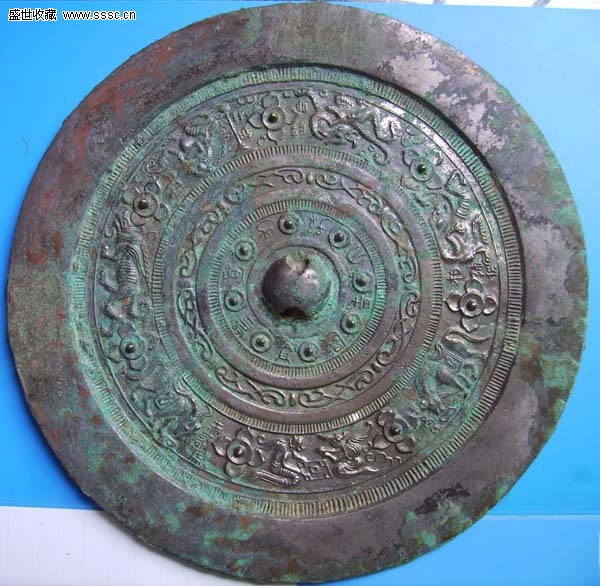
Source : 中秋到了,发一面;富贵寿宜神兽镜
Provenance : Unknown.
Current Location : In a private collection.
Date : Eastern Han (25 CE – 220 CE)
Size : 22.2 cm. in diameter.
Notes : A very similar, but not identical design to 5.1. The central inscription is one character shorter (富貴壽宜子孫大吉), and runs in the opposite direction. The middle ring has the same seven panels and exactly the same labels, but the images are mirrored compared with 5.1. The outer ring is blank.
Last updated: 2022-02-18.
Index of BabelStone Blog Posts
